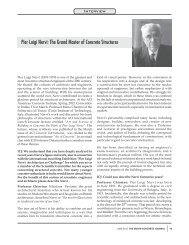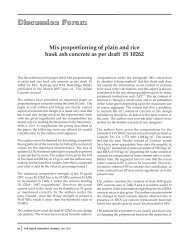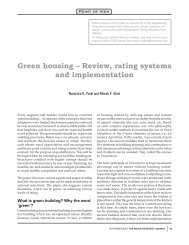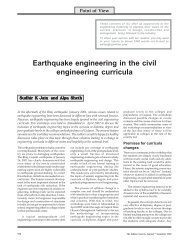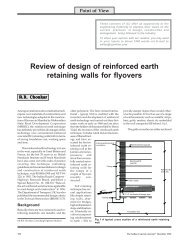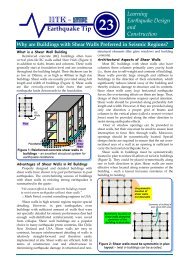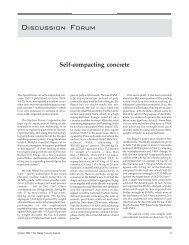Low-cost housing : Common mistakes in construction - The Indian ...
Low-cost housing : Common mistakes in construction - The Indian ...
Low-cost housing : Common mistakes in construction - The Indian ...
Create successful ePaper yourself
Turn your PDF publications into a flip-book with our unique Google optimized e-Paper software.
Civil eng<strong>in</strong>eer<strong>in</strong>g has made a vast progress<br />
with the development of new materials and<br />
sophisticated techniques of <strong>construction</strong>.<br />
Quality control, time sav<strong>in</strong>g and reliability<br />
have become the motto of civil eng<strong>in</strong>eer<strong>in</strong>g.<br />
But, the <strong>construction</strong> of low-<strong>cost</strong> residential<br />
build<strong>in</strong>gs <strong>in</strong> India is dom<strong>in</strong>ated by the<br />
use of labour-<strong>in</strong>tensive technique of <strong>construction</strong>.<br />
<strong>The</strong>re is not much improvement<br />
<strong>in</strong> the quality of <strong>construction</strong> due to the<br />
follow<strong>in</strong>g reasons:<br />
• old traditional techniques of <strong>construction</strong><br />
are on-go<strong>in</strong>g as they are<br />
cheaper<br />
contractors<br />
and facilitate the<br />
• cheap labour attracts the local contractors<br />
as advanced mach<strong>in</strong>es are<br />
<strong>cost</strong>ly<br />
• old techniques of <strong>construction</strong> <strong>in</strong>volve<br />
more labour than mach<strong>in</strong>es<br />
• about 50 percent of contractors<br />
have not undergone civil eng<strong>in</strong>eer<strong>in</strong>g<br />
education<br />
<strong>The</strong> follow<strong>in</strong>g <strong>construction</strong> <strong>mistakes</strong> are<br />
observed and overlooked dur<strong>in</strong>g the<br />
<strong>construction</strong> phase of residential build<strong>in</strong>gs.<br />
• <strong>The</strong> cement-sand mix <strong>in</strong> the mortar<br />
Unmesh C. Desai, Senior Civil Eng<strong>in</strong>eer, Narmada<br />
Chematur Petrochemicals Ltd, Bharuch, Gujarat.<br />
January 2001 * <strong>The</strong> <strong>Indian</strong> Concrete Journal<br />
Po<strong>in</strong>t of View<br />
<strong>The</strong>se columns of ICJ offer an opportunity to the<br />
eng<strong>in</strong>eer<strong>in</strong>g fraternity to express their views on the<br />
current practices <strong>in</strong> design, <strong>construction</strong> and<br />
management be<strong>in</strong>g followed <strong>in</strong> the <strong>in</strong>dustry.<br />
To share your op<strong>in</strong>ion with our readers, you may send<br />
<strong>in</strong> your <strong>in</strong>puts <strong>in</strong> about 1500 words via E-mail to<br />
editor@icjonl<strong>in</strong>e.com<br />
<strong>Low</strong>-<strong>cost</strong> <strong>hous<strong>in</strong>g</strong> : <strong>Common</strong> <strong>mistakes</strong> <strong>in</strong><br />
<strong>construction</strong><br />
Unmesh Unmesh C. C. Desai Desai<br />
Desai<br />
and brick masonry is made quite<br />
early, prior to its use and <strong>in</strong> larger<br />
quantities than required<br />
• <strong>The</strong> <strong>construction</strong> materials like<br />
sand, bricks, aggregates, etc, are not<br />
washed and are full of deleterious<br />
material and dust<br />
• Compaction of bottom strata <strong>in</strong><br />
foundation work is not carried out<br />
• Dur<strong>in</strong>g concret<strong>in</strong>g of foot<strong>in</strong>gs, the<br />
concrete is poured at a height<br />
greater than 1 m. Generally,<br />
trapezoidal foot<strong>in</strong>gs are resorted to,<br />
where concrete is never vibrated<br />
• Re<strong>in</strong>forced concrete (RC) columns,<br />
be<strong>in</strong>g an important part of the structure,<br />
are neither mechanically vibrated<br />
nor mach<strong>in</strong>e mixed. <strong>The</strong>y are<br />
cast <strong>in</strong> short lifts with <strong>in</strong>creased<br />
number of jo<strong>in</strong>ts<br />
• Cover to re<strong>in</strong>forcement <strong>in</strong> columns,<br />
beams and slabs is <strong>in</strong>sufficient<br />
• Misalignment of columns at foundation<br />
level and rectification at<br />
higher level, lead<strong>in</strong>g to eccentric<br />
load<strong>in</strong>g<br />
• RC cop<strong>in</strong>g at pl<strong>in</strong>th level be<strong>in</strong>g an<br />
important barrier to dampness is<br />
never densely cast<br />
• <strong>The</strong> pl<strong>in</strong>th fill<strong>in</strong>g is never carried out<br />
<strong>in</strong> layers nor compacted<br />
• at the jo<strong>in</strong>ts of RC and brick masonry,<br />
either the RC surface is not<br />
roughened or fill<strong>in</strong>g of mortar at the<br />
jo<strong>in</strong>t is not evident<br />
• <strong>The</strong> jo<strong>in</strong>ts of brick masonry at larger<br />
heights are improperly racked<br />
• Mix<strong>in</strong>g ratio <strong>in</strong> plaster and brick<br />
masonry is not ma<strong>in</strong>ta<strong>in</strong>ed<br />
• In the cases where beams are cast<br />
prior to slab:<br />
(i) <strong>in</strong> large slabs, the concrete <strong>in</strong><br />
beams starts sett<strong>in</strong>g before cast<strong>in</strong>g<br />
of RC slab<br />
(ii) the concrete spilled on the sides<br />
of beams while cast<strong>in</strong>g is never<br />
removed which gets set subsequently<br />
• Re<strong>in</strong>forcement of RC columns is<br />
kept exposed above RC slabs<br />
• Hack<strong>in</strong>g to concrete surface is poorly<br />
done prior to plaster<strong>in</strong>g<br />
• Bear<strong>in</strong>g to l<strong>in</strong>tel on both ends is not<br />
sufficient<br />
• In load-bear<strong>in</strong>g structures, secondary<br />
beams are rest<strong>in</strong>g directly on<br />
the walls giv<strong>in</strong>g po<strong>in</strong>t load<strong>in</strong>g<br />
15
• Corner re<strong>in</strong>forcement is not provided<br />
<strong>in</strong> two-way slabs lead<strong>in</strong>g to<br />
upliftment of corners<br />
• Proper care for uplift pressure <strong>in</strong><br />
black cotton soil is not taken <strong>in</strong>:<br />
(a) ground beam<br />
(b) comb<strong>in</strong>ed foot<strong>in</strong>g.<br />
<strong>The</strong>se <strong>construction</strong> <strong>mistakes</strong> can be<br />
easily taken care of dur<strong>in</strong>g the <strong>construction</strong><br />
phase. If neglected, these may result <strong>in</strong>:<br />
• cracks <strong>in</strong> concrete<br />
• improper bond<strong>in</strong>g between concrete<br />
and brick masonry<br />
• spillage of plaster<br />
• dampness <strong>in</strong> walls<br />
• leakages <strong>in</strong> slabs<br />
• cracks <strong>in</strong> brick masonry<br />
• settlement of foundations and<br />
walls.<br />
Failure prompts enquiry, whose<br />
purpose is to establish cause. When failure<br />
proves to be unusual or not well<br />
understood by the <strong>in</strong>dustry, it promotes<br />
Po<strong>in</strong>t of View<br />
research, which eventually feeds back <strong>in</strong>to<br />
standards and codes so that future design<br />
is better <strong>in</strong>formed. It is not the function of<br />
the codes to expla<strong>in</strong> or improve<br />
unacceptable performance <strong>in</strong> exist<strong>in</strong>g<br />
build<strong>in</strong>gs. Hence, the need for <strong>in</strong>vestigators<br />
and repairers to have a sound knowledge<br />
of defects and material behaviour and an<br />
appreciation that, knowledge is always<br />
<strong>in</strong>complete.<br />
<strong>The</strong> follow<strong>in</strong>g preventive/remedial<br />
measures are suggested for improvement<br />
<strong>in</strong> the quality of <strong>construction</strong> for low <strong>cost</strong><br />
residential build<strong>in</strong>gs.<br />
• <strong>The</strong> total civil work is executed<br />
ma<strong>in</strong>ly by labourers, masons and<br />
carpenters. A workshop or tra<strong>in</strong><strong>in</strong>g<br />
schedules shall be arranged for<br />
tra<strong>in</strong><strong>in</strong>g them. <strong>The</strong> tra<strong>in</strong><strong>in</strong>g will also<br />
improve their approach towards<br />
quality work.<br />
• Civil contractors who have undergone<br />
civil eng<strong>in</strong>eer<strong>in</strong>g education<br />
shall be preferred.<br />
• Time and <strong>cost</strong> factor also affects<br />
the quality of <strong>construction</strong>. In such<br />
cases, co-ord<strong>in</strong>ation between the architect,<br />
structural eng<strong>in</strong>eer and client<br />
plays a vital role <strong>in</strong> f<strong>in</strong>alis<strong>in</strong>g an<br />
appropriate design without sacrific<strong>in</strong>g<br />
functionality.<br />
• Prior test<strong>in</strong>g of <strong>construction</strong> materials<br />
like sand, yellow earth, bricks,<br />
aggregate, cement and re<strong>in</strong>forcement<br />
steel also helps to improve the<br />
quality of <strong>construction</strong>.<br />
• Overall, a good supervision by the<br />
civil contractor is essential dur<strong>in</strong>g<br />
the execution of <strong>construction</strong>.<br />
Experience is an expensive teacher,<br />
therefore, every attempt must be made to<br />
strengthen the technical skills of <strong>construction</strong><br />
professionals. <strong>The</strong> need to diagnose the<br />
cause of damage accurately, by consider<strong>in</strong>g<br />
all options before specify<strong>in</strong>g a remedy<br />
cannot be emphasised enough. Sav<strong>in</strong>gs<br />
made by preventive ma<strong>in</strong>tenance <strong>in</strong>clude<br />
not only the money that would have been<br />
spent on repair contracts but <strong>in</strong>direct <strong>cost</strong>s<br />
such as loss of bus<strong>in</strong>ess and <strong>in</strong>convenience<br />
to owners and users, which only goes to<br />
endorse the view that, always prevention is<br />
better than cure.<br />
•••<br />
1 6 <strong>The</strong> <strong>Indian</strong> Concrete Journal * January 2001







